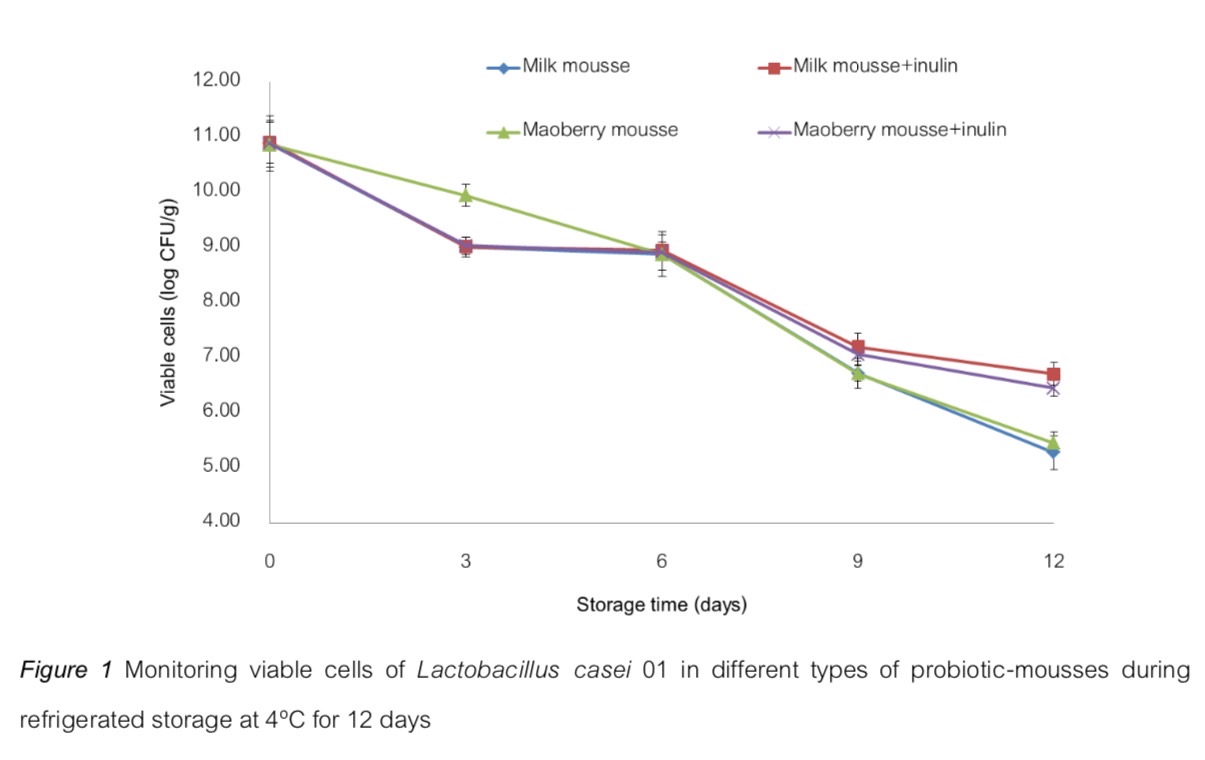การเปลี่ยนแปลงคุณภาพและการรอดชีวิตของ Lactobacillus casei 01 ในผลิตภัณฑ์ มูสนมสดและมูสเม่าเบอร์รี่เสริมอินูลินระหว่างการเก็บรักษาด้วยการแช่เย็น
คำสำคัญ:
มูสผลไม้ , เม่าเบอร์รี่ , พรีไบโอติก , โพรไบโอติกบทคัดย่อ
วัตถุประสงค์และที่มา : มูสเป็นของหวานที่มีเนื้อสัมผัสเบาและขึ้นฟูทำโดยการผสมอากาศเข้าไปในส่วนผสมของวิปครีม ไข่ขาวหรือเจลาติน จนกระทั่งมีเนื้อสัมผัสที่เรียบเนียนและนุ่มฟู เป็นได้ทั้งของหวานหรือคาว มูสที่นิยมรับประทาน เช่น มูสช็อกโกแลต และมูสผลไม้ เม่าเบอร์รี่หรือเม่าหลวง (Antidesma bunius) เป็นผลไม้เขตร้อนที่อุดมไปด้วยสารออกฤทธิ์ทางชีวภาพที่มีประโยชน์และจัดเป็นสารต้านอนุมูลอิสระ เช่น ฟลาโวนอยด์ และกรดฟีนอลิก จากข้อมูลทางวิทยาศาสตร์พบว่า สารดังกล่าวมีคุณสมบัติต้านการอักเสบ ต้านจุลชีพ และป้องกันโรคที่เกี่ยวข้องกับหัวใจ ช่วยส่งเสริมระบบย่อยอาหาร ควบคุมระดับน้ำตาลในเลือด และเสริมสร้างการทำงานของระบบภูมิคุ้มกันเนื่องจากมีวิตามินและแร่ธาตุสูง อินูลิน (inulin) เป็นเส้นใยพรีไบโอติก (prebiotics) จากธรรมชาติที่พบในพืชหลายชนิด เช่น รากชิโครี (chicory) กระเทียม และหัวหอม ซึ่งได้รับการยอมรับทางวิทยาศาสตร์ว่าช่วยส่งเสริมสุขภาพของลำไส้โดยการกระตุ้นการเจริญเติบโตของแบคทีเรียที่มีประโยชน์ต่อร่างกาย ช่วยให้การขับถ่ายเป็นปกติ และช่วยเพิ่มการดูดซึมสารอาหาร อินูลินยังสามารถช่วยควบคุมระดับน้ำตาลในเลือด และช่วยควบคุมน้ำหนักหรือควบคุมความอยากอาหารได้ จุลินทรีย์โปรไบโอติก (probiotics) มีประโยชน์ต่อสุขภาพโดยการส่งเสริมสุขภาพของลำไส้ ช่วยย่อยอาหาร และเสริมสร้างระบบภูมิคุ้มกัน นอกจากนั้นยังมีบทบาทสำคัญในการป้องกันความผิดปกติของระบบทางเดินอาหาร และช่วยในการควบคุมน้ำหนัก การบริโภคอาหารหรือเครื่องดื่มเสริมโพรไบโอติกอย่างสม่ำเสมอจะทำให้สุขภาพโดยรวมดีขึ้นได้อย่างมาก ดังนั้น งานวิจัยนี้มีวัตถุประสงค์ เพื่อศึกษาการเปลี่ยนแปลงคุณภาพและการรอดชีวิตของโพรไบโอติก Lactobacillus casei 01 ในผลิตภัณฑ์มูสนมสดและมูสเม่าเบอร์รี่เสริมอินูลินในระหว่างการเก็บรักษาด้วยการแช่เย็นที่อุณหภูมิ 4 องศาเซลเซียส เป็นเวลา 12 วัน
วิธีดำเนินการวิจัย : ทำการผลิตมูสเสริมโพรไบโอติกสูตรต่าง ๆ ได้แก่ มูสนมสด มูสนมสดเสริมอินูลิน มูสเม่าเบอร์รี่ มูสเม่าเบอร์รี่เสริมอินูลิน จากนั้นนำไปเก็บรักษาที่อุณหภูมิ 4 องศาเซลเซียส เป็นเวลา 12 วัน และสุ่มเก็บตัวอย่างทุกๆ 3 วัน และทำการวิเคราะห์คุณภาพด้านต่าง ๆ ได้แก่ ทางกายภาพ (ค่าสี และค่าความแน่นเนื้อ) ทางเคมี (ปริมาณของแข็งที่ละลายน้ำได้ทั้งหมด ค่าความเป็นกรด-ด่าง (pH) และปริมาณกรดที่ไตเตรทได้ทั้งหมด) และทางจุลชีววิทยาวิเคราะห์ หาปริมาณสารสำคัญ (กรดแอสคอร์บิก แอนโธไซยานินทั้งหมด และสารประกอบโพลีฟีนอลิกทั้งหมด) และฤทธิ์ในการต้านอนุมูลอิสระ (DPPH และ FRAP assays) รวมทั้งวิเคราะห์หาอัตราการรอดชีวิตของโพรไบโอติก L. casei 01ในตัวอย่างอีกด้วย
ผลการวิจัย : จากผลการทดลองพบว่า สารแอนโธไซยานินซึ่งเป็นรงควัตถุหลักที่พบในเม่าเบอร์รี่มีผลต่อค่าสี (L, a* และ b*) ของมูส แต่การเสริมอินูลินไม่มีผลต่อค่าสีของตัวอย่าง และพบว่า มูสที่มีส่วนผสมของเนื้อเม่าเบอร์รี่จะมีค่าความแน่นเนื้อและค่า pH ต่ำกว่ามูสนมสด และการเสริมอินูลินไม่มีผลต่อค่าความแน่นเนื้อและค่า pH ของมูส นอกจากนั้นยังพบว่า มูสที่มีส่วนผสมของเม่าเบอร์รี่มีปริมาณกรดแอสคอร์บิก แอนโธไซยานินทั้งหมด และสารประกอบโพลีฟีนอลิกทั้งหมด รวมทั้งประสิทธิภาพในการต้านอนุมูลอิสระ (DPPH และ FRAP assays) มากกว่ามูสที่ไม่มีส่วนผสมของเม่าเบอร์รี่ เมื่อเก็บรักษาในตู้เย็นที่อุณหภูมิ 4 องศาเซลเซียส ครบ 12 วัน พบว่า การเสริมเม่าเบอร์รี่มีผลต่อการเปลี่ยนแปลงของค่าสีมากกว่าการเสริมอินูลิน การเปลี่ยนแปลงของค่าสีของมูสเม่าเบอร์รี่เกิดจากการเสื่อมสภาพของแอนโธไซยานินเป็นหลัก ค่าความแน่นเนื้อของตัวอย่างมีค่าเพิ่มขึ้นจากวันแรกของการเก็บรักษา โดยเฉพาะอย่างยิ่งในมูสนมสดเสริมอินูลิน และยังพบว่าปริมาณของแข็งที่ละลายน้ำได้ทั้งหมดในตัวอย่างทั้งหมดมีค่าไม่เปลี่ยนแปลง แต่ค่า pH มีค่าลดลงเล็กน้อย ปริมาณกรดแอสคอร์บิก แอนโธไซยานินทั้งหมด และสารประกอบโพลีฟีนอลิกทั้งหมด รวมทั้งประสิทธิภาพในการต้านอนุมูลอิสระมีค่าลดลงในช่วงของการเก็บรักษา โดยในมูสที่มีส่วนผสมของเม่าเบอร์รี่ยังคงมีสารสำคัญและประสิทธิภาพในการต้านอนุมูลอิสระสูงกว่ามูสนมสดและมูสนมสดเสริมอินูลิน งานวิจัยยังชี้ให้เห็นถึงบทบาทของอินูลินในการเพิ่มอัตราการรอดชีวิตของโพรไบโอติก L. casei 01 ในระหว่างการเก็บรักษา โดยในมูสสูตรที่มีการเสริมอินูลิน จำนวนของ L. casei 01 ยังคงมีค่ามากกว่า 6 log CFU/g หลังจากการเก็บรักษาครบ 12 วัน ในทางตรงกันข้ามในสูตรที่ไม่มีการเสริมอินูลิน จำนวนของ L. casei 01 ลดลงต่ำกว่า 6 log CFU/g ภายในระยะเวลาเดียวกัน จะเห็นได้ชัดว่าจำนวนของ L. casei 01 ในมูสนมสดเสริมอินูลินและมูสเม่าเบอร์รี่เสริมอินูลินมีค่าเป็นไปตามมาตรฐานของโพรไบโอติกซึ่งควรมีจำนวนอย่างน้อย 6 - 7 log CFU/g ในอาหารก่อนนำไปบริโภค และจากการวิเคราะห์หาจำนวนจุลินทรีย์ทั้งหมด ยีสต์และรา และโคลิฟอร์ม รวมทั้งจำนวนจุลินทรีย์ก่อโรคชนิดต่าง ๆ ได้แก่ Escherichia coli, Listeria monocytogenes, Salmonella และ Staphylococcus aureus ในตัวอย่างทั้งหมดในระหว่างการเก็บรักษาพบว่าจำนวนจุลินทรีย์ทุกกลุ่มมีจำนวนอยู่ภายใต้มาตรฐานผลิตภัณฑ์จากนม
สรุปผลการวิจัย : โดยเม่าเบอร์รี่มีผลอย่างมีนัยสำคัญทางสถิติต่อค่าสี ความแน่นเนื้อ และ pH รวมทั้งปริมาณสารสำคัญและประสิทธิภาพในการต้านอนุมูลอิสระของมูส ส่วนอินูลินมีผลต่อค่าความแน่นเนื้อ และช่วยเพิ่มอัตราการรอดชีวิตของ L. casei 01 เมื่อเก็บรักษาครบ 12 วัน พบว่า จำนวนจุลินทรีย์ชี้วัดต่าง ๆ มีจำนวนอยู่ภายใต้มาตรฐานผลิตภัณฑ์จากนมซึ่งมีความปลอดภัยกับผู้บริโภค
เอกสารอ้างอิง
Aaby, K., & Amundsen, M. R. (2023). The stability of phenolic compounds and the colour of lingonberry juice with the addition of different sweeteners during thermal treatment and storage. Heliyon, 9, e15959
Announcement of the Ministry of Public Health. (2020). Define quality or standard: Terms and conditions and methods for analysis of food and disease-causing microorganisms (Issue 416). Ministry of Public Health, Bangkok, Thailand.
AOAC. (2005). Official methods of analysis (18th ed.). Washington, DC: Association of Official Analytical Chemists.
Bakr, S. A. (2015). The potential applications of probiotics on dairy and non-dairy foods focusing on viability during storage. Biocatalysis and Agricultural Biotechnology, 4, 423-431.
Benzie, I. F. F., & Stain, J. J. (1996). The ferric reducing ability of plasma (FRAP) as a measure of antioxidant power; the FRAP assay. Analytical Biochemistry, 239, 70-76.
Buriti, F. C. A., Castro, I. A., & Saad, S. M. I. (2010). Viability of Lactobacillus acidophilus in synbiotic guava mousses and its survival under in vitro simulated gastrointestinal conditions. International Journal of Food Microbiology, 137, 121-129.
Castañeda-Ovando, A., Pacheco-Hernández, M. L., Páez-Hernández, M. E., Rodríguez, J. A., & Galán-Vidal, C. A. (2009). Chemical studies of anthocyanins: A review. Food Chemistry, 113(4), 859-871.
Chaikham, P., & Apichartsrangkoon, A. (2012). Comparison of dynamic viscoelastic and physicochemical properties of pressurised and pasteurised longan juices with xanthan addition. Food Chemistry, 134(4), 2194-2200.
Chaikham, P., & Baipong, S. (2016). Comparative effects of high hydrostatic pressure and thermal processing on physicochemical properties and bioactive components of Mao Luang (Antidesma bunius Linn.) juice. Chiang Mai Journal of Science, 43(4), 851-862.
dos Santos, D. X., Casazza, A. A., Aliakbarian, B., Bedani, R., Saad, S. M. I., & Perego, P. (2019). Improved probiotic survival to in vitro gastrointestinal stress in a mousse containing Lactobacillus acidophilus La-5 microencapsulated with inulin by spray drying. LWT - Food Science and Technology, 99, 404-410.
Duquenne, B, Vergauwen, B., Capdepon, C., Boone, M. A., De Schryver, T., Van Hoorebeke, L., Van Weyenberg, S., Stevens, P., & De Block, J. (2016). Stabilising frozen dairy mousses by low molecular weight gelatin peptides. Food Hydrocolloids, 60, 317-323.
Gamage, G. C. V., Goh, J. K., & Choo, W. S. (2024). Application of anthocyanins from blue pea flower in yoghurt and fermented milk: An alternate natural blue colour to spirulina. International Journal of Gastronomy and Food Science, 37, 100957.
Garzón, G. A., & Wrolstad, R. E. (2002). Comparison of the stability of pelargonidin-based anthocyanins in strawberry juice and concentrate. Journal of Food Science, 67(4), 1288-1299.
Gibson, G. R., Hutkins, R., Sanders, M. E., Prescott, S. L., Reimer, R. A., Salminen, S. J., Scott, K., Stanton, C., Swanson, K. S., Cani, P. D., Verbeke, K., & Reid, G. (2017). Expert consensus document: The International Scientific Association for Probiotics and Prebiotics (ISAPP) consensus statement on the definition and scope of prebiotics. Nature Reviews Gastroenterology & Hepatology, 14, 491-502.
Giusti, M. M., & Wrolstad, R. E. (2001). Characterization and measurement of anthocyanins by UV‐Visible spectroscopy. Current Protocols in Food Analytical Chemistry, F1.2.1-F1.2.13.
Gomez-Betancur, A. M., Carmona-Tamayo, R., Jaimes-Jaimes, J., Casanova-Yepes, H., & Torres-Oquendo, J. D. (2020). Optimisation of yogurt mousse dairy protein levels: a rheological, sensory, and microstructural study. International Food Research Journal, 27(6), 1076-1086.
He, J., & Giusti, M. M. (2010). Anthocyanins: Natural colorants with health-promoting properties. Annual Review of Food Science and Technology, 1, 163-187.
Hongchai, P., Saentaweesuk, S., & Chaikham, P. (2023). Quality and acceptability of maoberry mousse product supplemented with inulin. Thai Science and Technology Journal, 31(6), 60-73. (in Thai)
Illippangama, A. U., Jayasena, D. D., Jo, C., & Mudannayake, D. C. (2022). Inulin as a functional ingredient and their applications in meat products. Carbohydrate Polymers, 275, 118706.
Jakobek, L. (2015). Interactions of polyphenols with carbohydrates, lipids and proteins. Food Chemistry, 175, 556-567.
Jorjong, S., Butkhup, L., & Samappito, S. (2015). Phytochemicals and antioxidant capacities of mao-luang (Antidesma bunius L.) cultivars from Northeastern Thailand. Food Chemistry, 15(181), 248-255.
Kamiloglu, S., Pasli, A. A., Ozcelik, B., Van Camp, J., & Capanoglu, E. (2015). Colour retention, anthocyanin stability and antioxidant capacity of black carrot (Daucus carota) jams and marmalades: Effect of processing, storage conditions and in vitro gastrointestinal digestion. Journal of Functional Foods, 13, 1-10.
Kemsawasd, V., & Chaikham, P. (2020). Effects of frozen storage on viability of probiotics and antioxidant capacities of synbiotic riceberry and sesame-riceberry milk ice creams. Current Research in Nutrition and Food Science, 8(1), 107-121.
Khan, I. T., Bule, M., Ullah, R., Nadeem, M., Asif, S., & Niaz, K. (2019). The antioxidant components of milk and their role in processing, ripening, and storage: Functional food. Veterinary World, 12(1), 12-33.
Khan, I. T., Nadeem, M., Imran, M., Ayaz, M., Ajmal, M., Ellahi, M. Y., & Khalique, A. (2017). Antioxidant capacity and fatty acids characterization of heat treated cow and buffalo milk. Lipids in Health and Disease, 16, 163.
Kheto, A., Bist, Y., Awana, A., Kaur, S., Kumar, Y., & Sehrawat, R. (2023). Utilization of inulin as a functional ingredient in food: Processing, physicochemical characteristics, food applications, and future research directions. Food Chemistry Advances, 3, 100443.
Kittibunchakul, S., Temviriyanukul, P., Chaikham, P, & Kemsawasd, V. (2023). Effects of freeze drying and convective hot-air drying on predominant bioactive compounds, antioxidant potential and safe consumption of maoberry fruits. LWT-Food Science and Technology, 184, 114992.
Krongyut, O., & Sutthanut, K. (2019). Phenolic profile, antioxidant activity, and antiobesogenic bioactivity of Mao Luang fruits (Antidesma bunius L.). Molecules, 24, 4109.
Lee, J., Durst, R. W., & Wrolstad, R. E. (2005). Determination of total monomeric anthocyanin pigment content of fruit juices, beverages, natural colorants, and wines by the pH differential method: Collaborative study. Journal of AOAC International, 88(5), 1269-1278.
Meyer, D., Bayarri, S., Tárrega, A., & Costell, E. (2011). Inulin as texture modifier in dairy products. Food Hydrocolloids, 25, 1881-1890.
Ngamlerst, C., Udomkasemsab, A., Kongkachuichai, R., & Kwanbunjan, K. (2019). The potential of antioxidant-rich Maoberry (Antidesma bunius) extract on fat metabolism in liver tissues of rats fed a high-fat diet. BMC Complementary Medicine and Therapies, 19(1), 294.
Ngamlerst, C., Vatthanakul, S., Leelawat, B., Supawong, S., & Prinyawiwatkul, W. (2023). The impact of inulin addition and high-pressure processing on physical characteristics of strawberry-flavoured egg white pudding. International Journal of Food Science and Technology, 58(3), 1230-1240.
Pap, N., Fidelis, M., Azevedo, L., do Carmo, M. A. V., Wang, D., Mocan, A., Pereira, E. P. R., Xavier-Santos, D., Sant’Ana, A. S., Yang, B., & Granato, D. (2021). Berry polyphenols and human health: evidence of antioxidant, anti-inflammatory, microbiota modulation, and cell-protecting effects. Current Opinion in Food Science, 42, 167-186.
Pojic, M., Mišan, A., Tiwari, B., & Šaric, B. (2015). Effects of inulin addition on physico-chemical and sensory characteristics of gluten-free cookies. Journal of Food Science and Technology, 52(1), 1-8.
Purkiewicz, A., Wisniewski, S., Tanska, M., Goksen, G., & Pietrzak-Fiecko, R. (2024). Effect of the storage conditions on the microbiological quality and selected bioactive compound content in fruit mousses for infants and young children. Applied Sciences, 14, 11347.
Ravula, R. R., & Shah, N. P. (1998). Selective enumeration of Lactobacillus casei from yogurts and fermented milk drinks. Biotechnology Techniques, 12(11), 819-822.
Roberfroid, M. B. (2007). Inulin-type fructans: functional food ingredients. The Journal of Nutrition, 137(11), 2493S-2502S.
Saad, N., Delattre, C., Urdaci, M., Schmitter, J. M., & Bressollier, P. (2013). An overview of the last advances in probiotic and prebiotic field. LWT - Food Science and Technology, 50(1), 1-16.
Shoaib, M., Shehzad, A., Omar, M., Rakha, A., Raza, H., Sharif, H. R., Shakeel, A., Ansari, A., & Niazi, S. (2016). Inulin: Properties, health benefits and food applications. Carbohydrate Polymers, 147, 444-454.
Siwalee, R., Wiriyaporn, S., Akharasit, B., & Samart, J. (2021). In vitro antioxidants and anticancer activity of crude extract isolates from Euphorbiaceae in Northern Thailand. The Thai Journal of Pharmaceutical Sciences, 45(5), 394-399.
Stobiecka, M., Król, J, & Brodziak, A. (2022). Antioxidant activity of milk and dairy products. Animals, 12, 245.
Tawali, S., Asad, S., Hatta, M., Bukhari, A., Khairi, N., & Rifai, Y., R, D. (2019). Anthocyanin-rich buni-berry (Antidesma bunius) extract increases paraoxonase 1 gene expression in BALB/c mice fed with a high-fat diet. Journal of Young Pharmacists, 11, 46-50.
Tian, X. Z., Lu, Q., Paengkoum, P., & Paengkoum, S. (2020). Effect of purple corn pigment on change of anthocyanin composition and unsaturated fatty acids during milk storage. Journal of Dairy Science, 103(9), 7808-7812.
Trang, D. T., Huyen, L. T., Nhiem, N. X., Quang, T. H., Hang, D. T. T., Yen, P. H., Tai, B. H., Anh, H. L. T., Binh, N. Q., Van Minh, C., & Van Kiem, P. (2016). Tirucallane glycoside from the leaves of Antidesma bunius and inhibitory NO production in BV2 cells and RAW264.7 macrophages. Natural Product Communications, 11, 935-937.
US Food and Drug Administration. (2001). Bacteriological analytical manual (BAM). Department of Health and Human Services, New Hampshire Avenue, Washington DC.
Wajs, J., Brodziak, A., & Król, J. (2023). Shaping the physicochemical, functional, microbiological and sensory properties of yoghurts using plant additives. Foods, 12(6), 1275.
Xavier-Santos, D., Bedani, R., Perego, P., Converti, A., & Saad, S. M. I. (2019). L. acidophilus La-5, fructo-oligosaccharides and inulin may improve sensory acceptance and texture profile of a synbiotic diet mousse. LWT - Food Science and Technology, 105, 329-335.
Zainol, M. K., Abd-Hamid, A., Yusof, S., & Muse, R. (2003). Antioxidative activity and total phenolic compounds of leaf, root and petiole of four accessions of Centella asiatica (L.) Urban. Food Chemistry, 81(4), 575-581.
Zulueta, A., Esteve, M. J., & Frígola, A. (2010). Ascorbic acid in orange juice-milk beverage treated by high intensity pulsed electric fields and its stability during storage. Innovative Food Science and Emerging Technologies, 11, 84-90.

ดาวน์โหลด
เผยแพร่แล้ว
รูปแบบการอ้างอิง
ฉบับ
ประเภทบทความ
สัญญาอนุญาต
ลิขสิทธิ์ (c) 2025 คณะวิทยาศาสตร์ มหาวิทยาลัยบูรพา

อนุญาตภายใต้เงื่อนไข Creative Commons Attribution-NonCommercial-NoDerivatives 4.0 International License.
Burapha Science Journal is licensed under a Creative Commons Attribution-NonCommercial-NoDerivatives 4.0 International (CC BY-NC-ND 4.0) licence, unless otherwise stated. Please read our Policies page for more information



